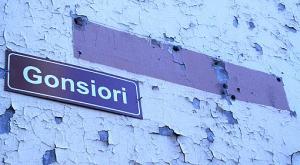It’s been so long since many streets in Eesti got their original, pre-Soviet names back that we tend to forget what was in the interim. For those who weren’t here at the time, imaging that Tallinn’s Toompuiestee was Juri Gagarini puiestee (boulevard) and that Kaarli pst, leading up to the twin-towered Kaarli kirik was Suvorovi pst, seems downright absurd. (18th c Russian Generalissimo Suvorov also had a cookie named after him during Soviet era.) But in some places, former shadows are still lurking, like here on the corner of Gonsiori and Pronksi in the heart of Tallinn (südalinn).
Contrary to popular belief, not all spots were named after red-hot Communists; in fact Mihhail Lomonossov (1711-1765) was quite a green-thinking Renaissance man. As a Russian scientist, encyclopaedist and poet, he made important contributions to literature, science and education. Moscow University and a moon crater are now named in his honour.
His predecessor (on this corner) was Jakob Johann von Gonsior, whose name suggests Prussian/German ancestry. Gonsior was a generous local raehärra (member of the town council), lawyer and orphanage founder, who is remembered for coming to the aid of a bankrupt gardener owning property on the street that now bears his name. In 1888 he bequeathed the lands of the current Viru hotell to the city.
Lomonossov’s long name was all over the news last week, when two Russian mini-submarines descended more than 4000 metres to the seabed at the North Pole in order to plant a national flag made of rust-proof titanium; this as a symbolic claim to nearly half the Arctic Ocean floor and the potential oil and gas resources there. Russian scientists are namely looking for evidence that the Lomonossov Ridge, a 2000 km underwater mountain range that crosses the polar region, is an extension of the Russian continental shelf. “The five Arctic nations can increase their rights to harvest seabed resources from the standard 200 nautical miles to as much as 350 nautical miles from their shores, if they can prove the area is part of their continental shelf,” the Globe and Mail reported on August 2.
“The Arctic always was Russian, and it will remain Russian,” expedition leader Artur Chilingarov told reporters on August 7 after he landed at Moscow's Vnukovo airport, where wellwishers brandished bottles of champagne and Russian flags. “We are happy that we placed a Russian flag on the ocean bed, where not a single person has ever been, and I don't give a damn what some foreign individuals think about that,” he said. Canada's Foreign Affairs Minister Peter MacKay dismissed the Russian's flag-planting tactics as “just a show.” “Look, this isn't the 15th century. You can't go around the world and just plant flags and say “We're claiming this territory,”” MacKay said last week. But what would the late, great scientist think of his nation’s tactics? Or would he fail to recognise it as his nation?
Lomonossov was here
Archived Articles | 10 Aug 2007 | EWR
Archived Articles
TRENDING



















